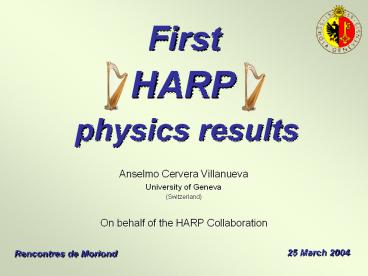Anselmo Cervera Villanueva - PowerPoint PPT Presentation
Title:
Anselmo Cervera Villanueva
Description:
Target: from hydrogen to lead. Motivation: ... hadron generator. correlation. independent. computed with. single particle MC. verified with data ... – PowerPoint PPT presentation
Number of Views:27
Avg rating:3.0/5.0
Title: Anselmo Cervera Villanueva
1
First
HARP
physics results
- Anselmo Cervera Villanueva
- University of Geneva
- (Switzerland)
On behalf of the HARP Collaboration
25 March 2004
Rencontres de Moriond
2
Overview
- The experiment and its objectives
- Detector performance
- Tracking
- Particle identification
- Closing the first analysis cycle
- Using our K2K thin target data
- Efficiencies
- Momentum and angular distributions
3
The HARP experiment
124 people
24 institutes
4
Physics goals
- Systematic study of HAdRon Production
- Beam energy 2-15 GeV
- Target from hydrogen to lead
- Motivation
- Pion/kaon yield for the design of the proton
driver of neutrino factories and SPL-based
super-beams - Input for precise calculation of atmospheric
neutrino flux - Input for prediction of neutrino fluxes for the
MiniBooNE and K2K experiments - Input for Monte Carlo generators (GEANT4, e.g.
for LHC, space applications)
5
Motivation of this analysis
One of the largest K2K systematic errors comes
from the uncertainty of the far/near ratio
pions producing neutrinos in the oscillation peak
To be measured by HARP
oscillation peak
K2K far/near ratio
En (GeV)
K2K interest
Beam MC confirmed by Pion Monitor
Beam MC
6
Geometrical acceptance
K2K interest
MC
K2K interest
P gt 1 GeV
7
Tracking
NDC4
Top view
NDC2
NDC1
NDC5
dipole magnet
target
1
beam
2
NDC3
momentum resolution
momentum bias
MC
case
1
No vertex constraint included
case
1
data
data
case
2
beam particles
8
p/p by Time of Flight
0-4.5 GeV
Beam time detectors
tw
target
L
t0
ta
tb
tc
tof wall
Tof Wall
target
data
- Tof wall resolution is 160 ps
- 7s p/p at 3 GeV
- beam time resolution is 180 ps
3 GeV beam particles
12.9 GeV K2K thin target
light particles
p
mom lt 4.5GeV
p
p
9
p/p by Threshold Cerenkov
3-15 GeV
e
p
- p / p above 3 GeV
- p / k from 3 to 9 GeV
number of photoelectrons
cerenkov
2.6 GeV
data
threshold for pions
9.2 GeV
threshold for kaons
3 GeV beam particles
5 GeV beam particles
p
p
p inefficiency
p inefficiency
p
p
e
number of photoelectrons
number of photoelectrons
10
electron / hadron
3 GeV beam particles
0-3 GeV
p
data
cerenkov
- Above 3GeV the electron and pion distributions
have a serious overlap
p
e
3 GeV beam particles
12.9 GeV K2K thin target
data
h
hadrons
calorimeter
e
small electron contamination
11
Efficiencies
- Pion efficiency in the (p,q) bin ij
tracking efficiency
pion efficiency
geometrical acceptance
depends on correlation between particles
correlation independent
correlation independent
may depend on hadron generator
estimated with MC verified with data
computed with single particle MC verified with
data
but can be compuded using the data
12
Tracking efficiency
NDC2
NDC5
NDC1
dipole
target
1
beam
- Sources of inefficiency
- hit efficiency (80)
- high hit density in NDC1
- PR confusion
2
- Improvements to came
- Use case
- Vertex constraint
single track eff
single track eff
2
3 MC hadron generators
13
Raw pion yield
data
12.9 GeV K2K thin target
all particles
identified pions
14
corrected by efficiency
integrated over q
integrated over P
arbitrary units
arbitrary units
identified pions
identified pions
proton background for Tof 3 MC hadron generators
- These plots reflect the lack of MC statistics
- Integrated over q and p
- No systematic errors included
IMPORTANT This background can be computed with
the data
15
Systematic sources
Initial estimation method Relevance Reduction
Acceptance Data small
Tracking efficiency Several hadron generators User defined final state medium Measure with data
Momentum angular biases Several hadron generators beam data particles small Vertex constraint
(p,q) bin migration (track purity) (p and q biases) (p and q finite resolution) Several hadron generators small Optimize (p,q) binning Reduce biases Improve resolution (vertex)
Proton background Several hadron generators small Can be fully measured in the data
Electron background Several hadron generators negligible Can be fully measured in the data
Kaon background Several hadron generators small Measured with data above 3GeV
16
Conclusions
420 million events
- HARP was proposed in 1999
- And recorded 420M events in 2 years
- Today we present our first physics results
- We have used 1/6 of our K2K thin target data
- and very limited MC statistics
- because we have used this analysis to set-up
our MC production mechanism (today 1M
events/day) - Pid detectors are well understood
- The vertexing algorithm already working (improve
) - Several ideas for recovering efficiency to be
implemented - Data statistics is not a problem (5.6 M events
after data quality) - Small systematic error expected
17
Next steps
- Analysis for K2K and MiniBooNE replica targets
- Full data statistics
- Large MC statistics
- 2D distribution (p, q)
- Detailed study of systematic errors
- and migration effects (expected to be small)
This program will be completed in 3 months and
presented at NEUTRINO 2004































